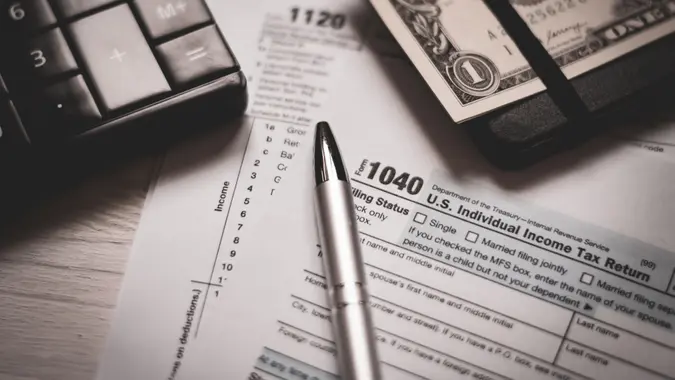Taxes for Millennials: How To Approach Filing if You’re Poor, Middle-Class, Upper Middle-Class or Rich

Commitment to Our Readers
GOBankingRates' editorial team is committed to bringing you unbiased reviews and information. We use data-driven methodologies to evaluate financial products and services - our reviews and ratings are not influenced by advertisers. You can read more about our editorial guidelines and our products and services review methodology.

20 Years
Helping You Live Richer

Reviewed
by Experts

Trusted by
Millions of Readers
Everyone’s favorite time of the year is just a month away: Tax Day. Anyone who works (that’s pretty much everyone) has to file tax returns. Millennials, those born between 1981 and 1996, comprise about 72 million people in the U.S. This generation makes up not only a large majority of the U.S. population but a large percentage of U.S. taxpayers.
Check Out: This Is the One Type of Debt That ‘Terrifies’ Dave Ramsey
While it might seem complicated to file based on your income bracket, it doesn’t have to be. Luckily, there are several ways that millennials can get ahead when it comes to filing taxes, regardless of their income bracket.
Tax Brackets Explained
According to GOBankingRates, the IRS uses federal income tax brackets to determine your tax liability.
IRS tax brackets are progressive, meaning that they’re broken up and tiered based on your taxable income level. This means different incomes (whether poor, middle-class, upper-middle-class or rich) are taxed at different federal income tax rates. For 2023, there are seven brackets for earnings which range from 10% to 37%.
2023 Tax Brackets
Here are the IRS tax brackets for tax year 2023. These brackets will determine your tax rate for 2023, ultimately affecting how much you owe (or how big of a refund) you’ll see come Tax Day next month.
Tax Brackets 2023
| TAX RATE | SINGLE | MARRIED FILING JOINTLY OR QUALIFYING SURVIVING SPOUSE | MARRIED FILING SEPARATELY | HEAD OF HOUSEHOLD |
| 10% | $0 to $11,000 | $0 to $22,000 | $0 to $11,000 | $0 to $15,700 |
| 12% | $11,001 to $44,725 | $22,001 to $89,450 | $11,001 to $44,725 | $15,701 to $59,850 |
| 22% | $44,726 to $95,375 | $89,451 to $190,750 | $44,726 to $95,375 | $59,851 to $95,350 |
| 24% | $95,376 to $182,100 | $190,751 to $364,200 | $95,376 to $182,100 | $95,351 to $182,100 |
| 32% | $182,101 to $231,250 | $364,201 to $462,500 | $182,101 to $231,250 | $182,101 to $231,250 |
| 35% | $231,251 to $578,125 | $462,501 to $693,750 | $231,251 to $346,875 | $231,251 to $578,100 |
| 37% | $578,126 or more | $693,751 or more | $346,876 or more | $578,101 or more |
How To Approach Tax Filing For Millennials
Here are some tips and tricks for millennials when it comes to filing taxes, according to SP Financial:
- Educate Yourself: Educating yourself about the current tax brackets and the latest developments in tax law will help you better understand how your income is taxed and what you can expect before you file.
- Increase Your Financial Literacy: This should go without saying that increasing your financial literacy is key. For example, understanding the proper withholdings to elect on your tax forms can ensure that you don’t withhold too little (or too much) tax from your paychecks. Proper withholdings can help ensure that you aren’t surprised with a big tax bill when you file or that you don’t give Uncle Sam a year-long interest-free loan on money that you could have kept in your wallet. Also, understanding what kinds of deductions you can take can help reduce your overall tax liability.
- Utilize Digital Tools: Take advantage of digital apps and tools such as advanced income tax estimators and basic tax calculators to help calculate your tax liability in advance. You can also find federal and state-specific tax calculators, which allow you to further estimate your overall tax liability no matter which bracket you fall into.
 Written by
Written by  Edited by
Edited by 

























